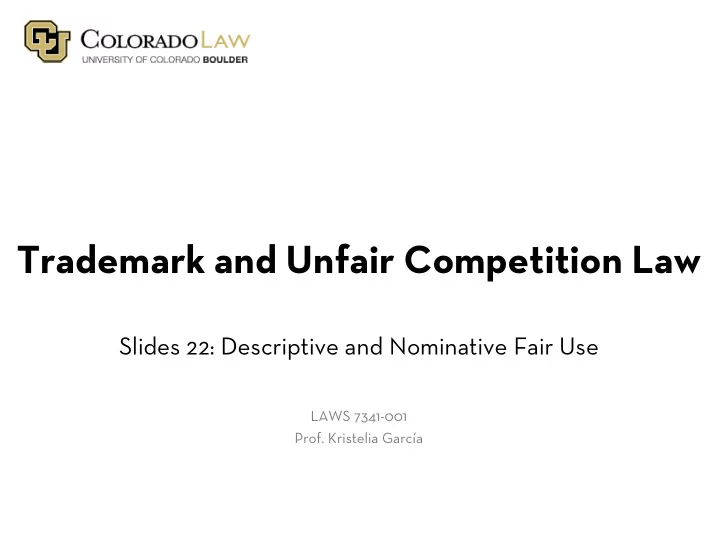

Trademark and Unfair Competition Law Slides 22: Descriptive and Nominative Fair Use LAWS 7341-001 Prof. Kristelia García
Class Outline • Descriptive Fair Use • Three-step test • Nominative Fair Use • Three-step test 2
Descriptive Fair Use Lanham Act § 33(b)(4): “…a use, otherwise than as a mark . . .of a term or device which is descriptive of and used fairly and in good faith only to describe the goods or services of such party . . .” In other words, use of a term to describe goods, and not used to as a mark to represent the product or service. 3
4
5
“[A] plaintiff claiming infringement of an incontestable mark must show likelihood of consumer confusion as part of the prima facie case…while the defendant has no independent burden to negate the likelihood of any confusion in raising the affirmative defense that a term is used descriptively, not as a mark, fairly, and in good faith (1115(b)(4)).” - KP Permanent Make-Up (Sup. Ct. 2004) 6
Lanham Act § 33(b)(4) Defines fair use as including use – “of a term or device which is descriptive of and used fairly and in good faith only to describe the goods or services of such party…” 7
Lanham Act § 43(c)(3) “The following shall not be actionable as dilution by blurring or dilution by tarnishment under this subsection: (A) Any fair use, including a nominative or descriptive fair use…” 8
Descriptive Fair Use as an Affirmative Defense (1) If the term describes some quality of the good or service, then defense applies • i.e. Speedy Delivery Service – any competitor can use “speedy,” no matter how much confusion it causes (2) Codified at 33(b)(4), there are two requirements: (a) the use of the challenged word or terms must be used “otherwise than as a mark” and (b) the challenged word or terms must be used “fairly and in good faith” 9
10
3-Step Test for Descriptive Fair Use 1. Is the mark being used other than as a mark? (i.e., other than to denote source) 2. Is the mark being used descriptively? 3. Is the mark being used in good faith? 11
Nominative Fair Use “[W]here the defendant uses a trademark to describe the plaintiff’s product, rather than its own, we hold that a commercial user is entitled to a nominative fair use defense [provided it meets the three-prong test…]” – 9 th Cir, New Kids on the Block 12
13
3-Part Test for Nominative Fair Uses: 1) The product or service in question must be one not readily identifiable without use of the mark; 2) Only so much of the mark may be used as is reasonably necessary to identify the product or service; 3) The user must do nothing that would suggest sponsorship or endorsement by the mark holder 14
Century 21 Real Estate Corp. v. Lendingtree, Inc., 425 F.3d 211 (3 rd Cir. 2005): “In announcing this new test, New Kids On The Block rejected traditional trademark infringement analysis. It held that this test replaces the “likelihood of confusion” test for trademark cases where nominative fair use is asserted . . . the Ninth Circuit Court of Appeals has elaborated . . .[that] the likelihood of confusion test as applied in nominative fair use cases would disadvantage the defendant by making confusion an all but foregone conclusion. . . . While we agree with the Ninth Circuit Court of Appeals that a distinct analysis is needed for nominative fair use cases, we do not accept the legal basis or advisability of supplanting the likelihood of confusion test entirely. . . [I]t is clear to us that even a defendant's nominative use has the potential of confusing consumers with respect to its products or services . . . . [E]ven an accurate nominative use could potentially confuse consumers about the plaintiff's endorsement or sponsorship of the defendant's products or services . 15
Recommend
More recommend